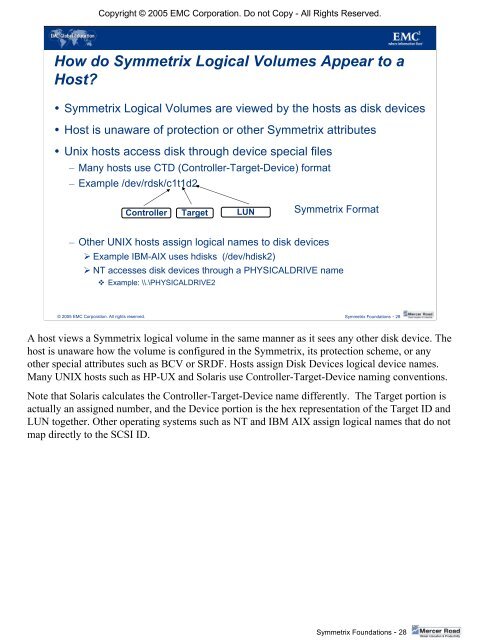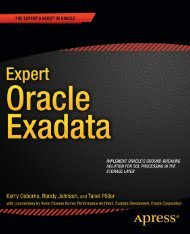student guide.pdf
student guide.pdf
student guide.pdf
Create successful ePaper yourself
Turn your PDF publications into a flip-book with our unique Google optimized e-Paper software.
Copyright © 2005 EMC Corporation. Do not Copy - All Rights Reserved.<br />
How do Symmetrix Logical Volumes Appear to a<br />
Host?<br />
• Symmetrix Logical Volumes are viewed by the hosts as disk devices<br />
• Host is unaware of protection or other Symmetrix attributes<br />
• Unix hosts access disk through device special files<br />
– Many hosts use CTD (Controller-Target-Device) format<br />
– Example /dev/rdsk/c1t1d2<br />
Controller Target LUN Symmetrix Format<br />
– Other UNIX hosts assign logical names to disk devices<br />
‣ Example IBM-AIX uses hdisks (/dev/hdisk2)<br />
‣ NT accesses disk devices through a PHYSICALDRIVE name<br />
Example: \\.\PHYSICALDRIVE2<br />
© 2005 EMC Corporation. All rights reserved. Symmetrix Foundations - 28<br />
A host views a Symmetrix logical volume in the same manner as it sees any other disk device. The<br />
host is unaware how the volume is configured in the Symmetrix, its protection scheme, or any<br />
other special attributes such as BCV or SRDF. Hosts assign Disk Devices logical device names.<br />
Many UNIX hosts such as HP-UX and Solaris use Controller-Target-Device naming conventions.<br />
Note that Solaris calculates the Controller-Target-Device name differently. The Target portion is<br />
actually an assigned number, and the Device portion is the hex representation of the Target ID and<br />
LUN together. Other operating systems such as NT and IBM AIX assign logical names that do not<br />
map directly to the SCSI ID.<br />
Symmetrix Foundations - 28











